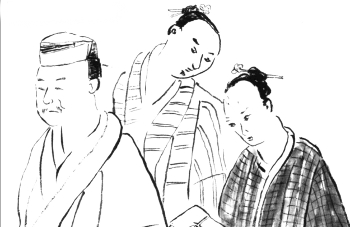In 1762, a Ryūkyūan tribute ship bound for Satsuma drifted ashore at Ōshima, a small island off the southern tip of Tosa province in today’s Kōchi Prefecture 高知県. From the exchange with a Ryūkyūan named Shiohira Pēchin, the young Confucian scholar Tobe Yoshihiro 戸部良煕 created a comprehensive record. This is called the Ōshima Hikki 大島筆記.
At that time the author Tobe inquired in great detail about Ryūkyū, and especially also about China. Moreover there are around 60 ryūka or Ryūkyūan poems recorded in it, including explanations, and also pseudoclassical Japanese-style stories as well as a myriad of other topics from government organization to chitchat.
Among karate people the Ōshima Hikki is most famous for its note on the Chinese military officer referred to as “Kūsankū”.
Probably because the work has only compariatively limited value within Japanese studies, and because it is an obsolete and difficult language — and generally because most students have different focal points than that –, it has never been translated into English. It appears also never to have been translated into modern Japanese.

Illustration of clothes and headgear of Ryūkyūans.
Especially among karate researchers this “emphasis on ignorance” is even more astonishing when recognizing the actual value and content of the Ōshima Hikki in terms of Ryūkyūan history, culture, and of course martial arts — the real martial arts of that time.
On the right, see an illustration of clothes and headgear of Ryūkyūans from the Ōshima Hikki edition of Kōchi Prefectural Library.
For the above reason I start a number of short installments in an attempt to show some of the unique und fascinating contents of the Ōshima Hikki. That is, I will attempt to interpret some of the matters.
It should be noted that there are a large number of different editions of the Ōshima Hikki, and their content is generally not 100% identical, but there are subtle differences. So far a detailed comparison and revision of the contents has not been carried out. When adding up the contents of various editions, it is about the following that emerges as a table of contents:
- Order of Ryūkyūans Who Drifted Ashore (琉人漂着次第)
- Conditions in Ryūkyū (琉球国躰)
- People and Customs (人物風俗)
- Broad Outline of a Whole Year (年中大略)
- The Matter of Offices and Ranks (Official Ranks) (官位之事)
- The Matter of the Dynastic Dress Code of the Nobility When Serving or Attending Court (朝服之事)
- Place Names (地名)
- Broad Classification of Products (産物大様)
- Broad Outline of the Ryūkyū Language (琉語大略)
- Conversations Part I (雑語上)
- Conversations Part II (雑話下)
- Reconsideration (再考)
- Pictures and drawings (図絵)
- Encounter with Chinese and Japanese poetry (出会詩歌; karauta 漢詩 and waka 和歌)
- Songs and poetry of Ryūkyū (琉球歌)
- Waka poems of the Ryūkyūans (琉球人和歌)
- “The Tale of the Rainy Evening” (Amaya-monogatari) (雨夜物語)
- “Nagamine Wabun” (永峯和文)
Info on the sources
The main text I used here was prepared by Yokoyama Manabu in:
- Okinawa no Rekishi Jōhō Kenkyūkai: Okinawa no Rekishi Jōhō Dai Roku Maki. Gazō to zenbun tekisuto dēta bēsu (II): 4. Ōshima Hikki gazō to tekisuto dêta bêsu. Yokoyama Manabu sakusei. 2. “Ōshima Hikki” gazō to tekisuto dēta bēsu. 沖縄の歴史情報研究会。沖縄の歴史情報 第6巻。画像と全文てきすとでーたべーす(II)。(4)「大島筆記」画像とてきすとでーたべーす。横山學作成。2. 「大島筆記」画像とてきすとでーたべーす。宝玲山田氏本「大島筆記」乾。宝玲山田氏本「大島筆記」坤。
It used the 1. Kenkadō 蒹葭堂-edition of the Ōshima Hikki from the Cabinet Library (naikaku bunko 内閣文庫), 2. the Ōshima Hikki of the Universität of Hawaii, Hōrei Bunko Yamada-uji (ハワイ大学宝玲文庫・山田氏), 3. Ōshima Hikki der Universität von Hawaii, Hōrei Bunko (ハワイ大学宝玲文庫) and Nishijō Bunko (西荘文庫), and furthermore the – Ōshima Hikki from the Kyōto University Library 京都大学図書館, – Ōshima Hikki from the Kagoshima Prefectural Library 鹿児島県立図書館, and the – Ōshima Hikki from the Kōchi Prefectural Library 高知県立図書館 (Mori Uji Bunko 森氏文庫).
Links:
- ‘Sky’-Volume and the ‘Earth’-Volume of the Hōrei Yamada-uji Hon 宝玲山田氏本「大島筆記」乾 and 「大島筆記」坤.
- Ōshima Hikki from the Iha Fuyō Bunko 伊波普猷文庫 from the Okinawa Special Collection Digital Archives of the University of the Ryukyus Library.
- Ōshima Hikki from the Kōchi Prefectural Library 高知県立図書館 (Mori Uji Bunko 森氏文庫).
© 2016, Andreas Quast. All rights reserved.
